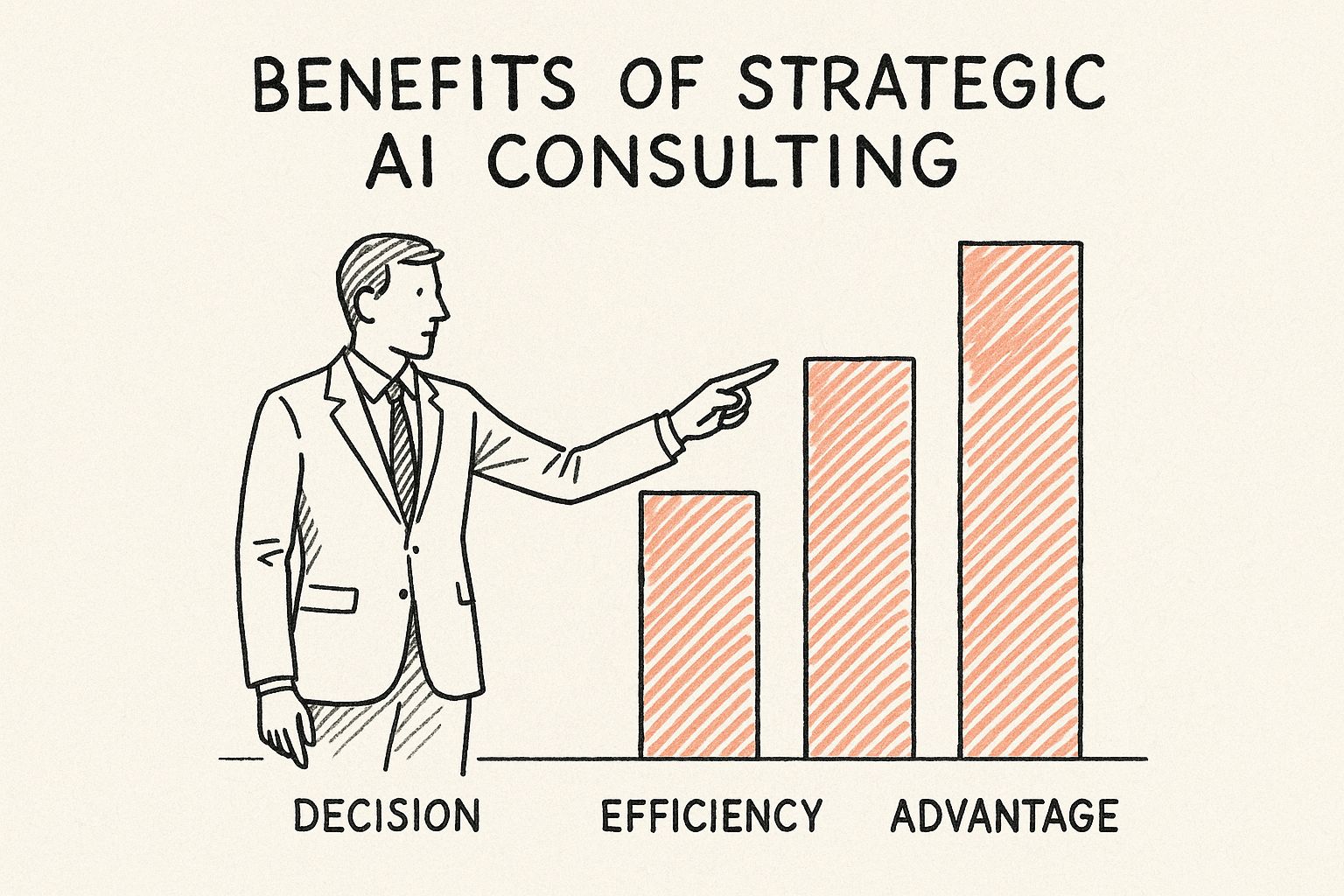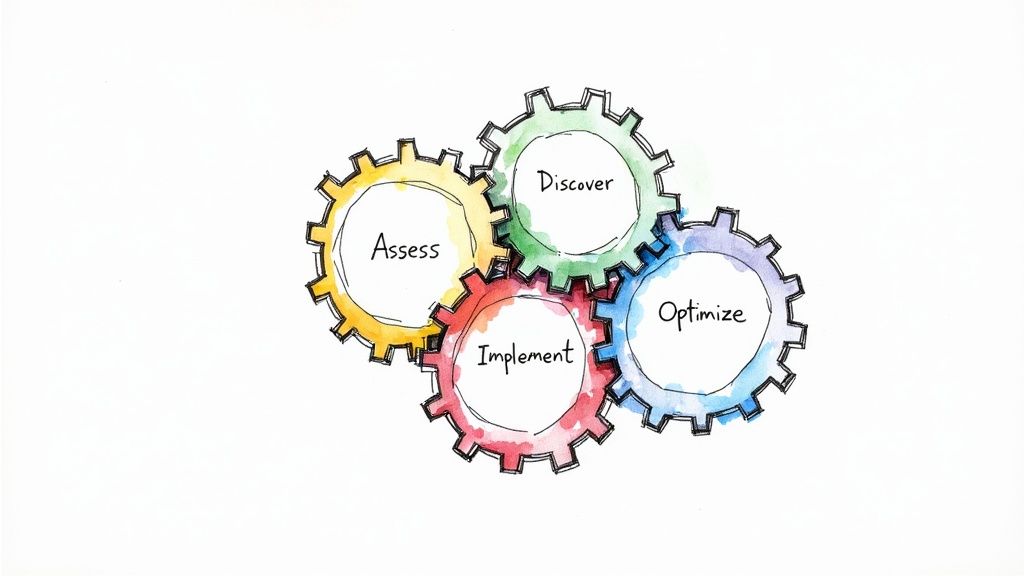Strategic AI Consulting for Business Growth
Unlock business growth with strategic AI consulting. Our guide covers building a powerful AI roadmap, choosing the right tools, and driving tangible results.

Think of it this way: you wouldn't start building a skyscraper by just ordering a bunch of steel and concrete. You’d bring in an architect first to draw up a detailed blueprint. That's exactly what strategic AI consulting does for your business—it provides the architectural plan for your AI initiatives, making sure every move is deliberate and connected to a larger goal.
This is a far cry from just installing the latest software. It's a deeply collaborative process focused on understanding your core business objectives and then figuring out how powerful AI tools can help you achieve them. This alignment is what separates a successful AI program from an expensive experiment.
What Is Strategic AI Consulting
So, what does this actually look like in practice? It’s about creating a detailed blueprint that connects artificial intelligence directly to your most important business goals. The entire point is to make technology serve your strategy, not the other way around. This idea of close partnership is the foundation of effective AI strategy consulting.
Moving Beyond Technology for Technology's Sake
Too many companies get caught up in the hype. They hear about a new AI tool and rush to implement it, only to find it doesn't solve a real problem. Or they launch massive projects without having the right data infrastructure in place. These missteps are common, and they lead to wasted money, blown deadlines, and a general sense of disappointment with what AI can do.
Strategic consulting is designed to prevent these exact pitfalls. As we explored in our AI adoption guide, a thoughtful approach is critical.
The goal is to build a clear, actionable roadmap that produces measurable results. We're not talking about fuzzy benefits; we're talking about tangible outcomes like:
- Boosting top-line revenue: By uncovering new market opportunities or creating hyper-personalized customer experiences.
- Streamlining internal operations: By intelligently automating the repetitive, manual tasks that drain your team's time and energy.
- Creating a lasting competitive edge: By using data to make smarter, faster decisions than anyone else in your industry.
This practical, results-oriented approach is quickly becoming the standard. The market for strategic AI consulting is expected to hit around $15 billion in 2025 and is on track to grow at a Compound Annual Growth Rate (CAGR) of 25% through 2033. Businesses are waking up to the fact that AI isn't just a tech trend—it's a powerful engine for optimization and a serious competitive weapon. You can see this trend reflected in recent market analysis reports.
The Difference Between a Tool and a Strategy
It's critical to understand that a technical project is not the same as a strategic initiative. One is about installation; the other is about impact.
The table below breaks down how strategic AI consulting shifts the entire conversation from just getting tech up and running to creating real, measurable business value.
Strategic AI Consulting vs Traditional IT Projects
Focus Area Traditional IT Project Approach Strategic AI Consulting Approach
Starting Point
A specific technology or tool to be installed.
A specific business problem or opportunity.
Primary Goal
Successful deployment and functionality of the technology.
Achieving a measurable business outcome (e.g., cost reduction).
Key Metric
Project delivered on time and on budget.
Tangible ROI and impact on key performance indicators.
Team Focus
Technical teams execute a predefined plan.
Cross-functional teams collaborate to solve business challenges.
As you can see, the mindset is completely different.
Ultimately, strategic AI consulting is about asking "why" before you even think about "how." It’s about making sure every single dollar you invest in AI is directly tied to a clear, valuable business outcome. For any leader serious about making a real impact with artificial intelligence, this is the essential first step. This foundational concept of partnership is the very essence of AI co creation, where we work hand-in-hand with you to turn technological potential into tangible business victories.
The Core Pillars of Your AI Strategy
A powerful AI strategy isn't just a single grand idea. It’s a structure built on several essential pillars, each one supporting the others. Think of it like building a house—if you skimp on the foundation or use a weak frame, the whole thing becomes unstable. Neglecting any of these core areas in your AI plan can lead to wasted effort, blown budgets, and results that just don't impress.
A successful strategy needs to balance four critical areas, starting from the big-picture business goals and drilling down to the people who make it all happen. This comprehensive approach is the heart of effective strategic AI consulting; it ensures every move you make is deliberate and contributes to the bottom line. At Ekipa, we help you build this foundation, starting with a deep dive into your specific needs.
Aligning AI with Business Goals
First things first: Business Goal Alignment. This is the most crucial pillar. Every single AI initiative you consider must be directly tethered to a clear business objective. Instead of chasing AI because it's the hot new thing, you should be asking practical questions. "How can AI help us boost customer retention by 15%?" or "Can we use AI to cut our supply chain operational costs by 20%?"
Without that direct connection, AI projects can quickly become expensive science experiments that look interesting but deliver zero real-world value. A tight alignment ensures your tech investments are solving genuine, urgent business problems. It's this focus on outcomes that separates a true strategy from just playing with technology.
Ensuring Data Readiness and Governance
The second pillar is Data Readiness. It’s a simple truth: data is the fuel for any AI model. If your fuel is low-quality or contaminated, your engine will sputter and fail. This goes beyond just having a lot of data; it's about the quality, accessibility, and governance of that information.
You need to ask some hard questions:
- Is our data accurate and complete? Garbage in, garbage out. Flawed data leads to flawed AI and bad business decisions.
- Can we actually get to the data we need? Data trapped in departmental silos is a common and serious roadblock that has to be cleared.
- Do we have clear rules for our data? Knowing who owns the data and how it can be used is non-negotiable for security and compliance.
This is a massive focus area right now, especially as large enterprises are going all-in on AI. The demand for well-integrated AI is skyrocketing, with IT consulting leading the way because they manage the underlying infrastructure and data. As of 2024, North America accounts for over 36% of the global AI consulting market, and large enterprises make up a staggering 69.4% of that demand. This just highlights how critical it is to get your data house in order.
This chart shows how a solid strategy creates a domino effect, leading to better decisions, improved efficiency, and a stronger competitive edge.

You can see the clear progression here—each benefit builds directly on the last, ultimately giving you a real advantage in the market.
Selecting the Right Technology and Tools
Pillar number three is Technology and Tool Selection. The AI market is flooded with platforms and software, and it’s easy to get sidetracked by the latest shiny object. A strategic approach means picking tools that solve your specific problems, not just the ones getting the most hype.
This involves measuring potential solutions against your business needs, your current tech stack, and your plans for growth. The goal isn't to force your business to conform to a generic tool; it's to find a tool that fits your unique context like a glove.
Integrating People and Processes
Finally, we have the fourth pillar: People and Process Integration. Technology doesn't drive change on its own—people do. This pillar is all about the human side of AI adoption. You need to make sure your team has the right skills and that your daily workflows are redesigned to actually benefit from the new tech.
This means investing in training, managing the change process, and rethinking how work gets done to fully capitalize on AI's power. When your team truly understands and buys into the new tools, that's when you unlock their full potential. The entire journey should result in a clear, actionable guide for your organization. We help you create a Custom AI Strategy report that serves as that exact blueprint for success.
Building Your AI Implementation Roadmap
Once you’ve settled on a core strategy, it’s time to get your hands dirty. A brilliant AI strategy is just a nice idea until you create a practical, step-by-step plan to bring it to life. This is where strategic AI consulting pivots from planning to action, guiding you through a phased journey that turns ambition into real results and minimizes risk along the way.
Forget trying to make one giant leap. The best approach is a series of controlled, deliberate steps. Each phase builds on the last, creating momentum and making sure the project stays true to its original goals. This structured method helps you sidestep the scope creep and budget blowouts that plague so many complex tech projects.
Phase 1: Discovery and Goal Setting
The first phase is all about finding the perfect starting point—the place where AI will make the biggest splash. It means taking a deep dive into your operations to pinpoint the specific processes or bottlenecks where AI can deliver the most significant, immediate value. This isn't a vague brainstorming session; it’s a focused hunt for the “low-hanging fruit” that can deliver a quick win and build confidence across the company.
Key activities here include:
- Opportunity Identification: We sift through potential applications to find the sweet spot—a project with both high business impact and solid technical feasibility.
- KPI Definition: Right from day one, we set clear, measurable metrics for success. Instead of a fuzzy goal like "improve efficiency," we aim for something concrete, like "reduce manual data entry by 30% within three months."
- Stakeholder Alignment: We make sure everyone, from the C-suite to the front-line teams, is on the same page about the project's goals and how they'll contribute to its success.
This foundational work ensures your first AI project is primed for a decisive victory.
Phase 2: The Pilot Project
With a high-impact opportunity in your sights, the next move is to launch a pilot project. Think of this as a small-scale, low-risk initiative designed to prove the concept's value without a massive commitment. A successful pilot acts as powerful internal marketing, showcasing AI's potential and building the critical momentum needed for wider adoption.
A pilot project is really just a controlled experiment. You test your hypothesis on a small scale, gather real-world data, and prove it works before you even think about a full-scale rollout. This approach minimizes risk and maximizes learning.
This is the perfect time to explore a gallery of real-world use cases to see how other companies have cracked similar problems. Drawing inspiration from proven successes can spark new ideas and help refine your own approach. Ultimately, a well-run pilot gives you the hard evidence you need to justify further investment.
This visual from our strategy work shows how a clear plan, starting with a pilot, leads to measurable outcomes.

The image clearly maps the journey from initial strategy to scaled impact, underscoring why a phased, structured plan is so essential.
Phase 3: Scaled Implementation
After a successful pilot, you have the proof, the data, and the internal buy-in to move to the next phase: scaled implementation. This is where the solution is carefully expanded across an entire department or even the whole organization.
But this isn't just about "flipping a switch." It requires careful planning to manage the transition smoothly. For a deeper look at what this stage involves, our guide on implementation support offers great insights into managing this process effectively. The focus shifts to robust deployment, user training, and weaving the new AI-powered workflow into daily operations without causing disruption.
Phase 4: Continuous Optimization
The final phase—and arguably the most important for long-term success—is Continuous Optimization. Your AI systems aren't static tools; they're living assets that can, and should, evolve. This phase is all about monitoring performance against your KPIs, gathering feedback from users, and retraining models with new data.
This constant refinement ensures the systems become more accurate and effective over time. It's this iterative cycle of improvement that guarantees your AI investment delivers sustained, compounding value for years to come.
Of course. Here is the rewritten section, designed to sound like an experienced human expert.
How AI Delivers Tangible Business Value
Let's be clear: strategic AI isn't about chasing sci-fi concepts or installing flashy tech for bragging rights. It's a focused business discipline. The entire point is to produce measurable, concrete results that show up on your bottom line. When an AI strategy is done right, the value it creates usually falls into three main buckets, each one directly impacting your company's performance and long-term health.
This focus on real-world outcomes is what separates strategic AI consulting from just another IT expense. It’s about building a solid business case for every single initiative and tracking its return from the get-go. This is central to our whole approach of AI co-creation, where we partner with you to turn technological potential into tangible business wins.
Enhanced Operational Efficiency
One of the first places you'll see AI make a difference is in operational efficiency. Think about all the repetitive, rule-based tasks that eat up your team's day. AI is a workhorse for automating these processes, whether they're in finance, HR, or customer service.
For instance, AI can handle invoice processing, screen thousands of resumes to pinpoint top candidates, or answer routine customer questions without missing a beat. This isn't just about cutting costs. It frees your talented people from monotonous work so they can focus on what they do best: strategic planning, creative problem-solving, and building genuine customer relationships.
Superior Decision-Making
Beyond just doing things faster, AI gives your leadership the tools to make smarter, more data-backed decisions. This is where AI stops being a simple cost-saver and becomes a real strategic asset. By digging through massive datasets, predictive models can spot patterns and forecast outcomes with a precision no human team could ever hope to match.
Imagine what this means for your supply chain. An AI model can analyze historical sales, weather forecasts, and even global news to predict demand, preventing costly stockouts or wasteful overstocking. In marketing, it can identify a market trend just as it’s bubbling up, letting you jump on the opportunity before anyone else. It effectively turns high-stakes guesswork into a science.
The real power of AI in business is to augment human intelligence, not replace it. It provides the deep insights you need to make confident decisions in a complex world, giving you a much sharper competitive edge.
The demand for this kind of insight is why the AI services sector is booming. The AI consulting services market is projected to jump from USD 11.07 billion in 2025 to an incredible USD 90.99 billion by 2035. That explosive growth shows just how deeply industries like finance, retail, and manufacturing are weaving AI into their core operations.
A Sustainable Competitive Advantage
When you combine streamlined operations with smarter decisions, you get the ultimate prize: a sustainable competitive advantage. When you’re leaner and more intelligent in your actions, you can simply outmaneuver the competition.
This advantage shows up in a few key ways:
- Innovative Products and Services: Use AI to analyze customer feedback and find gaps in the market, sparking ideas for new offerings that customers actually want.
- Hyper-Personalized Customer Experiences: Tailor everything from marketing emails to product recommendations for each individual, building powerful loyalty.
- Discovery of New Revenue Streams: Uncover opportunities buried deep in your data, allowing you to break into new markets or even invent new business models.
By tying every AI project to clear, concrete business goals, you stop just "doing AI." You start building a smarter, more resilient organization that’s ready not just to compete, but to lead. That's the real promise of strategic AI consulting—turning technology into a lasting business asset.
How We Accelerate Your AI Journey
Let's be honest: traditional consulting can be painfully slow. It often gets stuck in a cycle of endless meetings, theoretical workshops, and hefty overheads that seem to delay any real progress. We saw this firsthand and knew there had to be a better way.
That’s why we built Ekipa AI from the ground up to be different. Our approach combines purpose-built technology with deep human expertise, cutting through the usual clutter to deliver clear, actionable results in a fraction of the time. This isn't about rushing things; it's about being smarter. We skip the long, drawn-out phases of typical consulting and get right into a hands-on partnership, moving you from an initial idea to a scalable plan with speed and confidence.

A Tech-Powered Discovery Process
We start by putting a powerful tool directly into your hands. The journey begins with our AI Strategy consulting tool, which is designed to make the discovery phase remarkably efficient. This interactive platform guides you through outlining your business challenges, defining what success looks like, and pinpointing potential AI opportunities in a clear, structured way.
Think of it as a replacement for weeks of back-and-forth emails and introductory calls. It lets you map out your vision on your own terms and gives us the essential data we need for a truly informed analysis. This tech-first approach means our very first strategic conversation is already miles ahead of a typical kickoff meeting.
From Analysis to Action in Record Time
Once you’ve shared your vision through the tool, our system helps structure that information for strategic review. This isn’t just a simple form—it’s an analytical engine that sets the stage for what comes next. And this is where the human expertise becomes essential.
Our expert team takes your structured inputs and applies our internal frameworks. They draw on years of industry knowledge to connect your specific goals to proven, viable AI solutions. It’s this blend of your business knowledge and our AI know-how that allows us to quickly build a plan that works for you.
We believe the best strategies are built together. Our process is a form of AI co creation, where your business knowledge and our AI expertise merge to create a plan that is both ambitious and achievable.
This accelerated collaboration means we can produce a comprehensive Custom AI Strategy report far faster than a conventional consultancy. Instead of waiting months for a dense PowerPoint deck, you get a clear, concise, and actionable blueprint designed to get you moving.
Our Agile and Focused Methodology
Our entire model is built to remove friction and get you to value, faster. We do this by sticking to a few core principles that set our strategic AI consulting apart from the old way of doing things.
Here’s a look at how our approach is different:
- From Theory to Practice: We skip the generic, abstract presentations. Every recommendation we make is grounded in practical application and tied to exploring proven real-world use cases.
- From Workshops to Tools: Instead of locking your team in a boardroom for days, we use smart tools like our AI requirements analysis generator. This gathers precise information without disrupting your team's schedule.
- From Slow to Swift: Our process is designed for speed. We turn your initial ideas into a solid strategy quickly, helping you build momentum and start seeing results much sooner. After all, early wins are critical for building long-term support for any new initiative.
This modern approach to AI strategy consulting ensures your journey is about doing, not just planning. We give you the clarity and the tools you need to move from ambition to execution with confidence.
Of course. Here is the rewritten section, designed to sound natural and human-written, as if from an experienced expert.
Common Questions About Strategic AI Consulting
It’s completely normal for even the most innovative business leaders to have questions about AI. This isn't just another tech upgrade; it's a fundamental shift in how business gets done. So, let's clear up some of the most common questions we hear from people trying to figure out their next move.
My goal here is to give you straightforward answers, cut through the hype, and show you the practical value of getting your AI strategy right from the very beginning.
How Is This Different From Regular IT Consulting?
This is a fantastic question because the distinction is crucial. Traditional IT consulting is usually about deploying a specific piece of technology. Think installing new software, managing servers, or upgrading a system. The main goal is simple: does the technology work?
Strategic AI consulting, however, starts from a completely different place. It doesn't begin with the tech; it begins with your business objectives. The core question we ask is, "Where can AI create the most significant impact on our business?" That could be anything from driving sales and slashing operational costs to inventing entirely new revenue streams. Success isn't just a functioning tool—it's a measurable boost to your bottom line.
Can We Benefit Without Any Prior AI Experience?
Absolutely. In fact, companies with little to no AI experience often stand to gain the most from this kind of strategic guidance. One of the biggest mistakes we see is companies jumping in headfirst without a plan. They end up wasting a lot of time and money on projects that go nowhere, which often leads them to mistakenly conclude, "AI just isn't for us."
Think of an AI consultant as a seasoned guide leading you through unfamiliar territory. They know the landscape, can point out the safest and most rewarding first steps, and will help you steer clear of the common traps that snag so many others.
Starting with a solid strategy prevents those expensive missteps. It ensures you build your AI foundation correctly from the ground up, setting you up for long-term success.
How Do You Ensure a Return on Investment?
For us, ROI isn't something we calculate at the end of a project; it's the central pillar of the entire strategy from day one. We ensure every single AI initiative is tied directly to a specific, measurable Key Performance Indicator (KPI).
So, instead of a fuzzy goal like "improve customer satisfaction," we aim for concrete targets like "reduce customer support ticket resolution time by 40%."
We almost always kick things off with a small-scale pilot project. This low-risk approach is designed to prove the concept's value quickly and generate a data-backed business case before you commit to a full-scale rollout. This process keeps everyone focused on what truly matters: delivering real, tangible results for your business. For a deeper dive into other common questions, feel free to explore our frequently asked questions page. If you're ready to start your AI journey with a partner you can trust, meet our expert team and see the difference firsthand.



